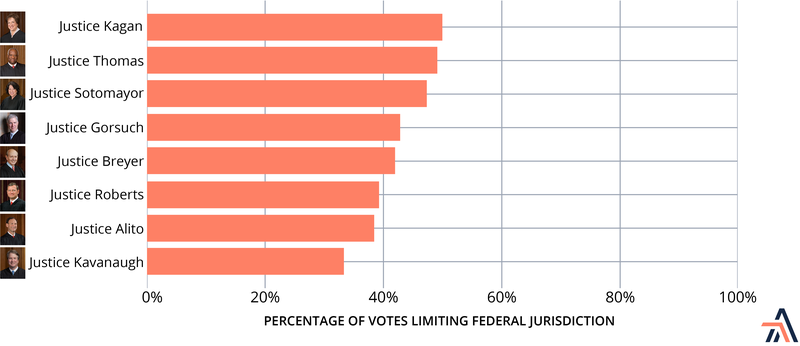What’s the issue?
PennEast has appealed to the Supreme Court, asking it to overturn a decision by the Third Circuit that held PennEast could not condemn land in which the state of New Jersey had an interest.
Why does it matter?
As the industry warned in pleadings this week, allowing the lower court decision to stand “would result in grave uncertainty for the Nation’s natural gas industry and supply.”
What’s our view?
Reversal of the lower court decision was given a boost when the U.S. Solicitor General’s office, now operating within the Biden administration, basically reaffirmed the position taken during the Trump administration, that the Supreme Court should reverse the lower court decision. However, even a win for the industry may not be enough to save PennEast. Another argument this week before the DC Circuit involving the Spire STL pipeline could put at risk PennEast’s pending application at FERC to build just the Pennsylvania portion of the project.
More than a year ago, PennEast appealed to the Supreme Court, asking it to reverse a decision by the U.S. Court of Appeals for the Third Circuit (Third Circuit) that held that PennEast could not condemn land in which the state of New Jersey held an interest. As explained by a number of parties who support PennEast’s appeal, the decision of the Third Circuit, if applied nationwide, would have serious practical consequences for the nation’s natural gas infrastructure and supply, and would essentially give the states “something akin to an absolute veto over federally-approved interstate pipeline projects. That new State-veto power at a minimum would push the natural gas industry into grave uncertainty, and at worst would halt needed infrastructure development (and operation).”
As we discuss today, it is far from certain how the Supreme Court will rule in this case, primarily because there are two very distinct issues it will be reviewing, and because there are simply a limited number of similar cases on which we could base a prediction of the outcome. In addition, a case involving the Spire STL pipeline heard earlier this week could still impact the PennEast project, even if it wins at the Supreme Court. This means the Supreme Court case may be more important for the industry as a whole than it will be for PennEast.
PennEast’s Problems with New Jersey
The state of New Jersey has been actively opposing the PennEast project almost from its initiation. Although FERC approved the project over three years ago, the state of New Jersey has not issued the necessary permits for the project to be constructed within that state. Part of the problem has been that the state has been insisting that the environmental impacts of the project be determined based on studies that can be completed only once the project has physical access to all properties to be crossed. Many landowners, including the state itself, refused to grant such access and that forced PennEast to launch condemnation actions following the receipt of its FERC certificate. New Jersey objected to the condemnation actions against any property in which it had an interest. The lower court ruled against New Jersey and the state appealed that decision to the Third Circuit. In what PennEast describes as a “novel, double-barreled ‘clear statement’ rule,” the Third Circuit held that a private company like PennEast could only condemn land held by a state if it could show that Congress, with unmistakable clarity, had delegated to that private entity both: (1) the federal government’s eminent-domain power and (2) the federal government’s exemption from Eleventh Amendment immunity. The Third Circuit found that in the Natural Gas Act (NGA), Congress had clearly done the first, but not the second.
PennEast Appeals
PennEast appealed the Third Circuit’s decision to the Supreme Court, but that court was not convinced it should even hear the appeal until it requested and received the views of the U.S. Solicitor General in December of last year. The Solicitor General suggested that the court should hear the case because the Third Circuit’s “decision is incorrect” in that the NGA condemnation authority “fully applies to property in which a State claims an interest.” But the Solicitor General also offered the court an alternative basis for reversing the lower court’s decision. In the Solicitor General’s view, the lower court didn’t even have jurisdiction in the case because the challenge to the condemnation was essentially a collateral attack on the FERC certificate and the NGA allows appeals of the certificate only to the D.C. Circuit or the circuit in which the natural-gas company has its principal place of business. However, PennEast’s application notes that it is a Delaware limited liability company and that its principal place of business is in Pennsylvania, both of which are within the Third Circuit, so it would appear that the Third Circuit could have entertained a challenge to the certificate, but not the lower court where this challenge by New Jersey was initiated.
The Supreme Court was persuaded to hear the case and asked the parties to file briefs on both the question of jurisdiction raised by the Solicitor General and the substantive question of whether the NGA allows condemnation of state-owned property. On March 1, PennEast filed its brief and on March 8, so did a number of industry groups that support PennEast. More importantly, though, given the change in the presidential administrations, the new acting Solicitor General also filed a brief that reiterates support for PennEast’s position on the substantive question and also continues to assert that the courts, in this case, lacked jurisdiction in the first place.
How Will the Supreme Court Rule?
This case presents an interesting array of possible outcomes depending on how the court views the case. The Third Circuit doubted whether a private party has the right to sue a state for condemnation because the Eleventh Amendment to the Constitution prohibits private parties from bringing suits in federal courts against the various states of the United States. Therefore, it held that, while the federal government had that authority, it would not allow a private party to do so without a clear delegation of the federal power by Congress, which the court did not find in the NGA.
That question alone could be considered either as a federal court jurisdictional question or a constitutional question under the Eleventh Amendment, although the Third Circuit took great pains to say it was not making a decision on the constitutional issue. The question first raised by the Solicitor General about the lower court’s authority is clearly a question about federal court jurisdiction, but turns much more on the interpretation of the statute in question, the NGA. Finally, the involvement of the Solicitor General creates an additional factor to consider. The Solicitor General is often described as the “tenth justice” of the Supreme Court, and the Solicitor General’s position would very likely be given more weight than a typical brief, especially in cases where the Solicitor General has been asked to provide an opinion.
In looking at the views of the current justices on federal court jurisdictional issues, it would appear that the views of the justices are not generally favorable for PennEast pretty much across the board.

However, looking a bit deeper into the data reveals why this data could perhaps be misleading. Most of these federal jurisdiction questions appear to turn on the specifics of the case and lead to very lopsided decisions that do not fall along traditional liberal and conservative lines. In looking at the votes in the comparable cases where at least six of the current justices participated, we find thirteen cases where all, or all but one, of the current justices agreed on the outcome. In only three of the cases, did the current justices split into two factions of at least two in disagreement with the others. In two of those three, the splits were not along traditional liberal/conservative lines, with Justice Alito agreeing with Justices Kagan, Breyer and Sotomayor in one, and in the second one, Justices Thomas and Alito agreeing with those same three liberal justices.
Therefore, in predicting this outcome, we put more weight on the involvement of the Solicitor General. In the last two Supreme Court sessions, the Solicitor General has filed seven briefs at the request of the court in which the Solicitor General recommended reversing the lower court, as it has in this case. In five of those seven instances, the majority of the court has followed that recommendation. Based on this factor alone, we think it is very likely that the Supreme Court will reverse the decision of the Third Circuit, in what may be a very lopsided vote. However, the basis of that reversal will be crucial, not only for the industry, but perhaps also for PennEast.
Possible Results and Their Impact
If the Supreme Court accepts the recommendation of the Solicitor General and reverses the Third Circuit on the grounds that the lower courts never had jurisdiction to decide the question, then there will be no clarity for the industry and this issue will likely be raised in another case. For PennEast, it may even be raised before the DC Circuit, which has appeals of the FERC certificate pending before it, but has delayed its review of those appeals while this case works its way through the court system. If the Supreme Court reverses the Third Circuit on the grounds that the NGA does give authority to pipelines to condemn state land, that will be a significant victory for the industry but not sufficient to allow PennEast to go forward, as we discuss below. If the Supreme Court upholds the Third Circuit, that would likely put a halt to almost all projects until a remedy can be passed through Congress. However, if the Supreme Court goes even further than the Third Circuit did and offers an opinion on whether the Eleventh Amendment prohibits actions to condemn state-owned property for the benefit of private companies, that could essentially spell the end of not only pipelines, but also all forms of energy corridors that run up against opposition at a state level.
PennEast Still Has Troubles
Even if PennEast wins at the Supreme Court, it will need to complete its environmental studies and obtain the necessary permits to construct in New Jersey. In the meantime, its proposal to build only the Pennsylvania portion of the project could be at risk due to a case that was argued earlier this week before the DC Circuit. That case involves the Spire STL pipeline and the key question being appealed is whether FERC must perform a more thorough assessment of the need for a project that has only affiliated shippers. During the oral argument, the court seemed very skeptical of the FERC position that, even in cases where the only contracts supporting the project are with affiliates of the pipeline, that FERC does not need to undertake an independent assessment of the need for a project.
This could be problematic for PennEast’s Pennsylvania phase which is pending at FERC because 100% of its contracts are with affiliates as well. Chairman Glick and Commissioner Clements have already expressed their dissatisfaction with relying exclusively on precedent agreements to determine need, especially when those contracts are primarily with affiliates, and an adverse decision in the Spire STL case could only strengthen their viewpoint.


